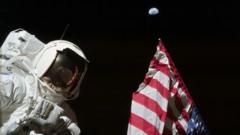What Are the Untold Stories of the Last Moon Men from NASA's Apollo Missions?

Pioneers of Space Exploration: The Legacy of NASA's Apollo Astronauts
As we look back on the remarkable achievements of space exploration, the Apollo missions stand out as a significant chapter in human history. The 24 NASA astronauts who ventured to the Moon during the Apollo missions of the 1960s and 1970s paved the way for future exploration beyond Earth. With the recent passing of Apollo 13 commander Jim Lovell, only five of these trailblazers remain, each with unique stories and contributions to humanity's ventures into space. In this article, we will explore the lives of these astronauts and the upcoming missions that promise to reignite our lunar ambitions.
The Apollo Program: A Brief Overview
The Apollo program was initiated in 1961, with the primary goal of landing humans on the Moon and returning them safely to Earth. This ambitious endeavor was not only a testament to human ingenuity but also a response to the geopolitical climate of the Cold War, particularly the space race between the United States and the Soviet Union. The program consisted of 17 missions, with Apollo 11 marking the first successful Moon landing on July 20, 1969.
Throughout its run, the Apollo program achieved numerous milestones, including the first crewed mission to reach the Moon's orbit (Apollo 8) and the first landing on the lunar surface (Apollo 11). The missions culminated with Apollo 17 in December 1972, which was the last time humans set foot on the Moon—until now. As we stand on the brink of a new era in space exploration, the legacy of the Apollo astronauts continues to inspire and influence the direction of future missions.
The Remaining Apollo Astronauts
With Jim Lovell's passing, the spotlight now shines on the remaining five Apollo astronauts who have walked on the Moon. Their stories are a blend of adventure, sacrifice, and an enduring commitment to space exploration. Let’s delve into their remarkable lives.
Buzz Aldrin: The Second Man on the Moon
On July 21, 1969, Edwin "Buzz" Aldrin made history as the second person to step onto the lunar surface, following Neil Armstrong. His first words upon exiting the lunar module were, "Beautiful view." Aldrin's contributions to the Apollo 11 mission were monumental, yet he has often expressed a complex relationship with his famous achievement—he reportedly resented not being the first person on the Moon.
Despite facing challenges in his later years, including mental health struggles, Aldrin has remained a staunch advocate for space exploration. He has actively promoted the importance of Mars exploration as the next frontier for humanity. In January 2023, at the age of 93, he married for the fourth time, showcasing his unyielding zest for life and adventure.
Charlie Duke: The Youngest Moonwalker
Charlie Duke made history as the youngest person to walk on the Moon at the age of 36 during the Apollo 16 mission in April 1972. Known for his Southern charm, Duke was also a key figure during the Apollo 11 landing, serving as the Capsule Communicator who relayed the historic communications between Neil Armstrong and NASA's mission control.
Duke has expressed enthusiasm for NASA's Artemis program, which aims to return humans to the lunar surface. He acknowledges the challenges awaiting the next generation of astronauts, particularly in the rugged terrain of the Moon's South Pole, where future missions are planned. Duke's life in Texas with his wife, Dorothy, reflects a deep appreciation for family and the divinity of exploration.
Fred Haise: A Brush with Disaster
Fred Haise was part of the Apollo 13 crew, which famously encountered a life-threatening crisis when an oxygen tank exploded en route to the Moon. Despite the mission being aborted, the world watched in awe as NASA orchestrated an incredible rescue operation that safely brought Haise and his crewmates back to Earth. Although he never walked on the Moon, Haise's contributions to space exploration are significant.
After leaving NASA, Haise worked as a test pilot for the space shuttle program and continued his career in the aerospace industry. His experiences during Apollo 13 provided invaluable lessons in crisis management and teamwork, which remain relevant in today's space missions.
Jack Schmitt: The Scientist-Astronaut
Unlike many of his Apollo counterparts, Jack Schmitt was not a military pilot but a geologist and academic. He played a pivotal role as part of the Apollo 17 crew, the last crewed mission to the Moon, where he contributed to the scientific understanding of lunar geology. Schmitt's expertise helped NASA collect valuable samples that continue to inform lunar research today.
After his NASA career, Schmitt transitioned into politics, serving one term in the U.S. Senate. His advocacy for scientific research and exploration has remained a hallmark of his post-NASA life, and he continues to engage in discussions about the importance of space exploration.
David Scott: The First Driver on the Moon
David Scott commanded Apollo 15, which marked a significant advancement in lunar exploration with the introduction of the Lunar Roving Vehicle (LRV). This vehicle allowed astronauts to travel greater distances on the lunar surface and conduct more extensive scientific investigations. Scott's leadership during this mission showcased the importance of innovation in space exploration.
Post-Apollo, Scott took on various roles within NASA and the private sector, contributing his expertise to numerous projects, including film and television. His experiences on the Moon continue to inspire new generations of astronauts and space enthusiasts.
The Future of Lunar Exploration: NASA's Artemis Program
As the world reflects on the achievements of the Apollo program, NASA's Artemis program is poised to reignite humanity's passion for lunar exploration. With a vision of returning astronauts to the Moon by the mid-2020s, the Artemis program aims to establish a sustainable human presence on the lunar surface and prepare for future missions to Mars.
Key Objectives of the Artemis Program
- Establishing a Lunar Gateway: A space station in lunar orbit that will serve as a hub for missions to the Moon and beyond.
- Exploration of the Lunar South Pole: Targeting this region for potential resources such as water ice, which could support future lunar habitation.
- Technological Innovation: Testing new technologies that will be critical for long-duration human spaceflight to Mars.
- International Collaboration: Partnering with other nations and private companies to share knowledge and resources.
Challenges Ahead
Despite the excitement surrounding the Artemis program, challenges remain. NASA has faced delays in its launch schedules, with Artemis 2's crewed mission now anticipated for 2026. Technological setbacks experienced by commercial partners like Boeing and SpaceX also underscore the complexities of modern space exploration.
Moreover, the harsh environment of the lunar South Pole presents unique challenges for the next generation of astronauts. The rough terrain and extreme temperatures may complicate landing and exploration efforts. However, the determination and innovation of the space community are likely to overcome these obstacles.
Conclusion: A Legacy That Inspires
The legacy of the Apollo astronauts is one of bravery, determination, and human spirit. As we stand on the cusp of a new era in lunar exploration with the Artemis program, we cannot forget the pioneers who first ventured into the unknown. The remaining Apollo astronauts serve as living reminders of our capacity for exploration and discovery. Their stories continue to inspire future generations to dream big and reach for the stars.
As we look forward to what the next generation of lunar adventurers will accomplish, one question lingers: What new discoveries await us on the Moon and beyond?
FAQs
Who were the astronauts on the Apollo missions?
The Apollo missions featured 24 astronauts who traveled to the Moon, with notable figures including Neil Armstrong, Buzz Aldrin, and Jim Lovell.
What is the Artemis program?
The Artemis program is NASA's initiative to return humans to the Moon, establish a sustainable lunar presence, and prepare for future missions to Mars.
What challenges does NASA face in lunar exploration?
NASA faces challenges such as technological delays, the harsh environment of the lunar South Pole, and the complexity of international collaboration.
As we prepare for the next chapter in lunar exploration, what role do you think private companies will play in advancing our understanding of space? #NASA #Apollo #Artemis
Published: 2025-08-08 22:09:09 | Category: world


